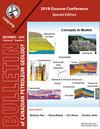阿尔伯塔省东北部古生代层序区域尺度测绘和建模的新见解:古地理、蒸发岩溶解和对白垩纪沉积模式的控制
Q3 Earth and Planetary Sciences
引用次数: 30
摘要
在详细的区域尺度岩石地层填图和模拟的基础上,更新了阿尔伯塔省东北部874个乡镇地区古生代地层的分布和范围。前寒武纪基底古地形强烈影响了桶河组碳酸盐岩聚集和聚集间盆地的分布,从而在很大程度上控制了上覆草原蒸发岩组的沉积模式。Keg河古地形控制了蒸发岩的沉积类型,特别是在草原蒸发岩组Whitkow段。Keg河古地形继续对草原蒸发岩组蒸发岩被层内溶解作用去除的地区的上覆沉积演替产生影响,包括白垩纪地层。在区域大草原蒸发岩溶蚀陡崖以东,水道地层覆盖Keg河古地形,特别是沿阿萨巴斯卡拱,加强了次白垩世不整合构造。利用现代井控技术对草原蒸发岩组进行构造填图和建模,并对其中的岩盐和硬石膏进行等径填图,为更新草原蒸发岩岩盐溶陡坡的位置和范围提供了依据。在大草原蒸发岩组中发现了一种新的区域相关标志层——康克林层。该标志层与先前建立的草原蒸发岩组地层和标志层地层进行了详细对比,揭示了盐岩溶蚀陡坡内蒸发岩岩溶的明确模式,并为整个研究区自上而下的岩盐去除提供了证据。区域性泥盆纪次crop模型,结合对次白垩统不整合的古地理重建,强调了草原蒸发岩组的喀斯特作用及其形成的泥盆纪构造对Mannville群上覆最下层地层的可容纳空间和沉积模式的控制作用。本文章由计算机程序翻译,如有差异,请以英文原文为准。
New insights from regional-scale mapping and modelling of the Paleozoic succession in northeast Alberta: Paleogeography, evaporite dissolution, and controls on Cretaceous depositional patterns on the sub-Cretaceous unconformity
Abstract The distribution and extent of Paleozoic strata within an area encompassing 874 townships in northeast Alberta have been updated based on detailed regional-scale lithostratigraphic mapping and modelling. Precambrian basement paleotopography strongly influenced the distribution of Keg River Formation carbonate buildups and interbuildup basins, which in turn largely controlled the depositional patterns in the overlying Prairie Evaporite Formation. Keg River paleotopography controlled the type of evaporites that were deposited, particularly at the Whitkow Member level of the Prairie Evaporite Formation. Keg River paleotopography continued to have an effect on the overlying sedimentary succession including the Cretaceous strata in areas where evaporites in the Prairie Evaporite Formation were removed by intrastratal dissolution. East of the regional Prairie Evaporite halite dissolution scarp, enhanced structuring of the sub-Cretaceous unconformity occurs by the draping of Waterways strata over Keg River paleotopography, especially along the Athabasca Arch. Structural mapping and modelling of the Prairie Evaporite Formation, and isopach mapping of halite and anhydrite therein using modern well control, provide the basis for an updated version of the location and extent of the Prairie Evaporite halite dissolution scarp. A new regionally correlatable marker bed, the Conklin, is introduced within the Prairie Evaporite Formation. Detailed correlation of this marker bed, along with previously established member and marker bed stratigraphy from the Prairie Evaporite Formation, reveals a well-defined pattern of evaporite karst within the halite dissolution scarp, and provides evidence for the top-down removal of halite throughout the study area. A regional Devonian subcrop model, together with a paleogeographic reconstruction of the sub-Cretaceous unconformity, highlight the control that karst processes in the Prairie Evaporite Formation and resulting Devonian structure have had on accommodation space and depositional patterns in the overlying lowermost formations within the Mannville Group.
求助全文
通过发布文献求助,成功后即可免费获取论文全文。
去求助
来源期刊

Bullentin of Canadian Petroleum Geology
Earth and Planetary Sciences-Geochemistry and Petrology
CiteScore
2.50
自引率
0.00%
发文量
0
期刊介绍:
The Bulletin of Canadian Petroleum Geology is a peer-reviewed scientific journal published four times a year. Founded in 1953, the BCPG aims to be the journal of record for papers dealing with all aspects of petroleum geology, broadly conceived, with a particularly (though not exclusively) Canadian focus. International submissions are encouraged, especially where a connection can be made to Canadian examples.
 求助内容:
求助内容: 应助结果提醒方式:
应助结果提醒方式:


